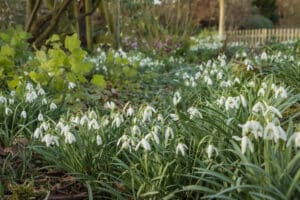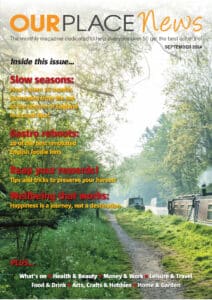It’s snowdrop season, when swathes of pint-sized white flowers emerge from frost-laden woodlands, parks, meadows and gardens, brightening up the winter vista. Seeing drifts of the pretty white flowers will shake off the winter blues.

If you want to ditch the winter blues, put on your walking boots and visit some gardens where you can find dazzling displays of these early-flowering beauties. Some of the best gardens include:
Anglesey Abbey, Cambridgeshire
With one of the most brilliant snowdrop collections in the country, visitors can see some 400 varieties here, many of which are rare. You’ll view many of them amid classical statues and the Winter Garden and notice that some are named after people and places with links to the abbey, including Galanthus ‘Hobson’s Choice’ named after former owner Thomas Hobson, who bought the abbey in 1627 and converted it from a derelict priory into a country house. Pre-book The Specialist Collection Tours, Monday – Friday and every Sunday from Jan 29 to Feb 29.
Wallington, Northumberland
Over the past few years, visitors have planted more than 800,000 snowdrops on the 13,500-acre estate at Wallington to keep the vibrant displays going. The collection includes a few special varieties of snowdrop, including the Northumbrian ‘Sandersii’ group, which has sulphur-yellow markings instead of green, and the pretty ‘Flore Pleno’ with double the usual number of petals. Half term is an ideal time to join the Wallington gardeners in planting these pretty spring flowers. Then take a walk to enjoy the carpets of snowdrops in the woodlands. ‘Flore Pleno’ wit. Snowdrop planting Feb 17-25.
Higher Cherubeer, Devon
Visitors to this beautiful private garden, which will open for three days in February, will see more than 400 snowdrop varieties, the National Collection of Cyclamen Species and many hellebores. The 1¾-acre country garden also features a gravelled courtyard and paths, raised beds, alpine house, lawns, herbaceous borders and woodland beds full of naturalised drifts of plants, plus a kitchen garden with large greenhouse and orchard. Feb 2, 9 and 17, National Garden Scheme.
Shepherd House, Inveresk, East Lothian
Recognised as one of the best small gardens in Scotland, this gorgeous one-acre plot was built in the late 17th century and is owned by Sir Charles and Ann Fraser. The season starts with its beautiful displays of snowdrops, with a collection of more than 70 cultivars. It’s a constantly evolving artist’s garden designed by its owners. No garden designer has been consulted. There was no overall plan so the garden has evolved in stages over the years. Tue/Thu from Feb 6-29, Scotland’s Gardens Scheme.
Bucklow Farm, Knutsford, Cheshire
This delightful private garden has been lovingly planted over the past 30 years with a myriad shrubs, perennial borders, rambling roses, herb garden, vegetable patch, meadow, wildlife pond/water feature and alpines. It’s a sight to behold when the ground is carpeted in snowdrops – which visitors can see when the garden is open to the public for one day in February through the National Garden Scheme – followed by other spring bulbs, while stems and berries provide colour and interest in autumn and winter. Sun, Feb 25, National Garden Scheme.
Kingston Lacy, Dorset
The gorgeous gardens surrounding this home which was built to resemble a Venetian palace feature thousands of snowdrops originally planted in the early 1900s and now featuring more than 40 varieties. The best places to see them are in the Japanese
Garden or along the Lime Avenue where they have naturalised under trees and bamboo. To beat the crowds, take up an early morning guided snowdrop walk on selected days in February. If you’re feeling adventurous, you can book a Kokedama workshop to create a hanging snowdrop moss ball to take home, or take up a snowdrop pixie pendant craft session to make to take home. Open daily in Feb.
Canons Ashby, Northamptonshire
There’s plenty for all the family, as visitors can join the Snowdrop Stories trail (Feb 10-25) , wandering through Canons Ashby, to discover what people have believed about these delicate and beautiful blooms through the years. There are two types of snowdrops which dominate here: Galanthus nivalis, which is a single type and in much larger quantities, and Galanthus nivalis f. pleniflorus ‘Flore Pleno’, also known as the common double snowdrop. They can be found throughout the garden including the avenue, garden and churchyard.
Dunimarle Castle, Dunfermline
The 19th century gardens in this beautiful estate feature a stunning woodland walk bordered by thousands of snowdrops in late winter, turning into a kaleidoscope of colourful flowers and ferns in summer. The lovingly restored castle, on the outskirts of the historic village of Culross, is surrounded by 52 acres of formal gardens, meadows and woodlands. Features include an Italianate terrace lined with yew trees and the formal Bastion Garden, a lovely backdrop to the original Georgian part of the castle, with its circular lawn and herbaceous borders. Open for snowdrops Feb 10/11, Scotland’s Gardens Scheme.
Chirk Castle, Wrexham, Wales
The gardens around this majestic medieval fortress within a 480-acre estate are peppered with snowdrops wherever you go, whether they are popping up among clipped yews, herbaceous borders, shrubs or rock gardens, as well as drifting along the woodland floor. The most impressive displays are in the Pleasure Ground Wood, next to the Formal Garden. Open daily in Feb.
Rowallane Garden, County Down
This colourful garden with spectacular views across the County Down countryside has grown from its 19th-century beginnings to be a bulb lover’s paradise, thanks to the planting of 130,000 bulbs over 10 years. It incorporates both formal and informal spaces, filled with unique plants from all over the world and celebrates late winter when drifts of pretty white snowdrops appear. Wrap up warm because the colder the weather, the longer they will last, with some flowering into March. Open daily in Feb.
(Article source: Silver Surfers)

